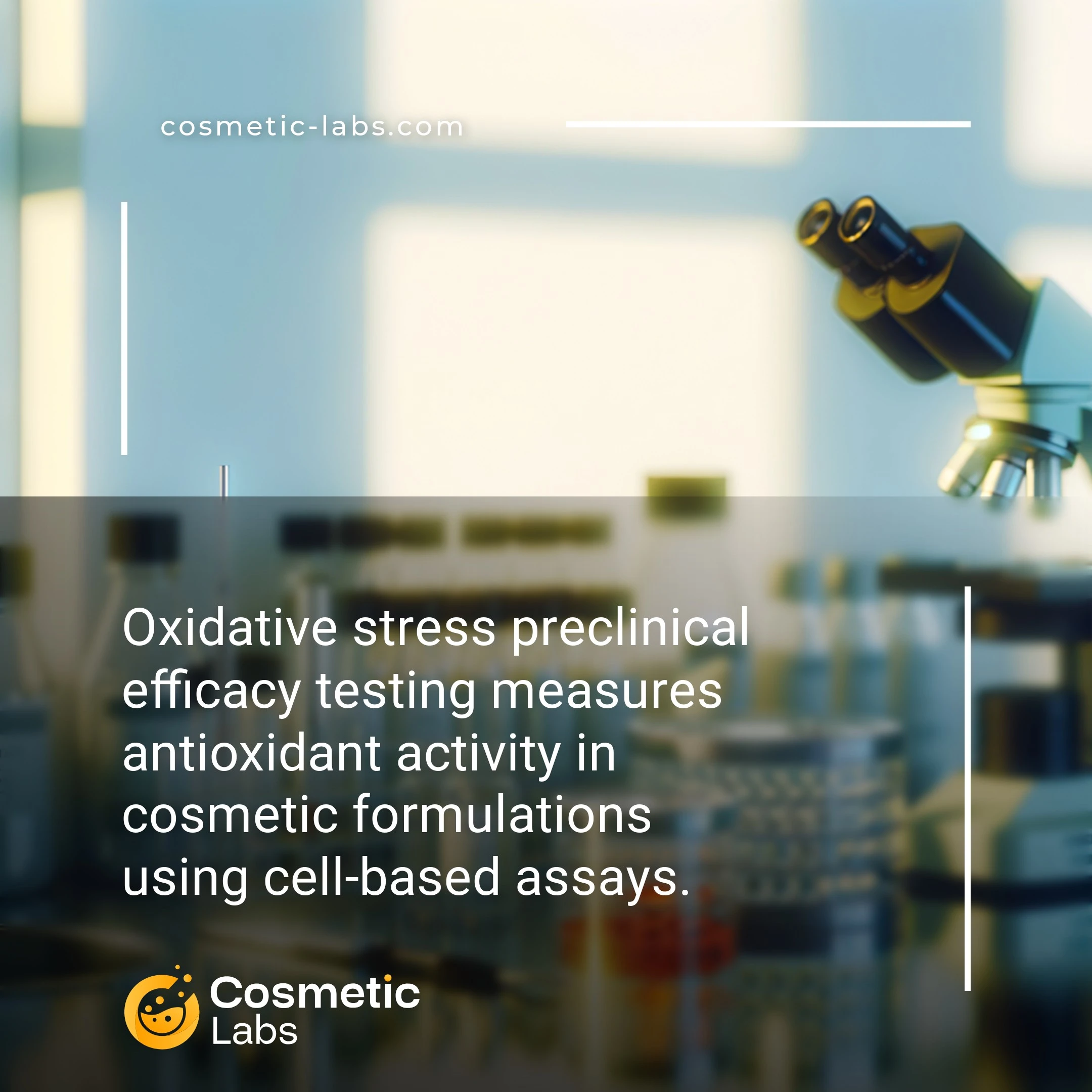Oxidative Stress Testing Services for Cosmetic Brands

What is Oxidative stress efficacy testing?
Oxidative stress preclinical efficacy testing services measure how well cosmetic ingredients and formulations protect skin cells from free radical damage before human trials begin. Labs use standardized cell culture assays to evaluate antioxidant capacity, measuring parameters like reactive oxygen species reduction and cellular viability under oxidative conditions. This testing helps brands validate anti-aging claims and optimize formulations with proven protective benefits.
Why do you need this service?
Cosmetic labs use oxidative stress testing to validate anti-aging claims for serums, creams, and treatments before market launch. Brand owners rely on these assays to demonstrate how their formulations protect skin cells from free radical damage, generating scientific data that supports marketing claims and meets regulatory requirements for product registration across different markets.
Who provides Oxidative stress efficacy testing services?
All cosmetic labs providing Oxidative stress efficacy testing services
There is no company providing these services at the moment.
Oxidative Stress Preclinical Efficacy Testing Services
Antioxidant claims require solid scientific backing before reaching consumers. Oxidative stress preclinical efficacy testing validates your product’s ability to protect skin cells from free radical damage through controlled laboratory environments.
Cell-Based Antioxidant Activity Assays
Labs measure your formulation’s protective effects using human keratinocytes and fibroblasts exposed to oxidative stressors. These in vitro models simulate UV radiation, pollution, and other environmental aggressors that accelerate skin aging.
Testing protocols include:
- DPPH radical scavenging assays
- Cellular ROS measurement
- Lipid peroxidation inhibition tests
- Glutathione depletion analysis
Results provide quantifiable data on your product’s antioxidant capacity, typically expressed as IC50 values or percentage inhibition rates.
Biomarker Analysis and Mechanism Studies
Advanced testing goes beyond basic antioxidant screening to examine specific cellular pathways. Labs analyze gene expression changes, protein modifications, and metabolic responses to understand how your ingredients work at the molecular level.
Key biomarkers evaluated include:
- Nrf2 pathway activation
- Inflammatory cytokine reduction
- Collagen synthesis enhancement
- DNA damage prevention markers
This mechanistic data strengthens your marketing claims and supports regulatory submissions. Connect with specialized labs on our platform to design custom testing protocols that align with your product positioning and target market requirements.
6 subcategories of Oxidative stress efficacy testing services
There are no results matching your search
Practical Applications of Oxidative Stress Preclinical Efficacy Testing
Cosmetic labs use oxidative stress preclinical efficacy testing applications to validate antioxidant claims and demonstrate protective benefits before human trials begin.
Anti-Aging Product Development
Labs evaluate how formulations protect skin cells from reactive oxygen species (ROS) damage using standardized assays like DPPH radical scavenging and lipid peroxidation inhibition tests. These protocols measure antioxidant capacity in vitamin C serums, retinol treatments, and peptide complexes within 24-72 hours.
Testing reveals specific protection percentages against UV-induced oxidative damage. Results support marketing claims about cellular protection and anti-aging efficacy before investing in clinical trials.
Sunscreen and Protective Formulations
Oxidative stress testing validates how sunscreens and daily moisturizers prevent free radical formation after UV exposure. Labs use cell culture models to measure DNA damage markers and inflammatory responses under controlled oxidative conditions.
Testing protocols include hydrogen peroxide challenge tests and photostability assessments. Data shows protection levels against environmental stressors, supporting broad-spectrum protection claims for regulatory submissions.
| Test Method | Primary Application | Results Timeline | Key Metrics |
|---|---|---|---|
| DPPH Radical Scavenging | Antioxidant serums | 24-48 hours | IC50 values, % inhibition |
| Lipid Peroxidation Assay | Anti-aging creams | 48-72 hours | MDA levels, protection % |
| Cell Viability Testing | Protective formulations | 72-96 hours | Cell survival rates |
| ROS Generation Analysis | UV protection products | 24-48 hours | Fluorescence intensity |
Ready to validate your antioxidant formulations? Connect with experienced cosmetic labs on our platform to design targeted oxidative stress testing protocols for your specific product claims.

